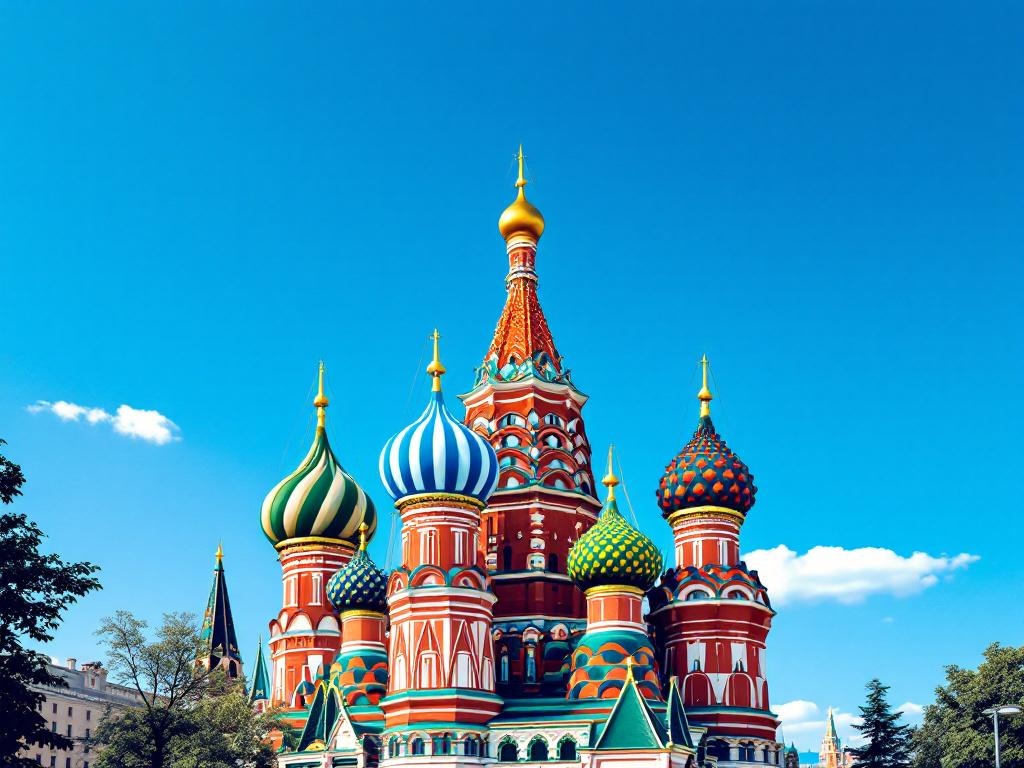Discovering St. Basil’s Cathedral in Moscow
Journey to Moscow’s Red Square and behold St. Basil’s Cathedral, a vibrant symbol of Russia’s history and spiritual heart. Commissioned by Ivan the Terrible, this UNESCO World Heritage Site boasts nine interconnected chapels, colorful onion domes, and a rich history of surviving fires, invasions, and political turmoil. Explore its stunning architecture, intricate frescoes, and over 400 icons. Discover the cultural significance of this architectural marvel. Plan your visit today and experience the magic of St. Basil’s.
Important information

- Located in Moscow’s Red Square, St. Basil’s Cathedral is a significant symbol of Russia’s cultural and spiritual heritage.
- Commissioned by Tsar Ivan the Terrible, the cathedral was built between 1555 and 1561, commemorating military victories.
- The cathedral’s unique architecture features nine interconnected chapels, vibrant onion domes, and red brick towers.
- Recognized as a UNESCO World Heritage Site, it houses a vast collection of icons, frescoes, and religious artifacts.
- Visitors can access the cathedral via the Moscow Metro and explore its museum exhibits, consider a guided tour for a richer experience.
Introduction to St. Basil’s Cathedral
St. Basil’s Cathedral, a vibrant symbol of the Russian Orthodox Church, graces Moscow’s Red Square. This architectural marvel stands as a powerful icon of the city’s cultural identity, offering visitors a glimpse into Russia’s rich history and spiritual heritage. Its central location makes it a key landmark.
Significance in Moscow
St. Basil’s Cathedral is a powerful symbol of Russia, representing the country’s strength, artistic brilliance, and spiritual heart. Its location near the Kremlin underscores its importance in Moscow. Attracting countless visitors every year, this landmark has witnessed key historical events, both religious and political. Its conversion from a church to a museum during the Soviet era ensured its survival. Today, St. Basil’s Cathedral reflects Moscow’s rich cultural heritage and stands as a testament to Russian identity and architectural innovation.
UNESCO World Heritage Site Status
St. Basil’s Cathedral, a UNESCO World Heritage Site since 1990, is renowned for its historical and architectural significance. This designation underscores its global importance.
Historical Background
Commissioned by Tsar Ivan the Terrible, the iconic St. Basil’s Cathedral was constructed between 1555 and 1561.
Throughout its history, this remarkable structure has faced numerous threats, from devastating fires to looming demolition.
It has persevered through the Time of Troubles, Napoleon’s invasion, and even the Soviet era.
St. Basil’s Cathedral stands today as a testament to its enduring strength.
Construction under Ivan the Terrible
St. Basil’s Cathedral, commissioned by Ivan the Terrible, was built between 1555 and 1561. This vibrant structure commemorates Russia’s triumphs over the Kazan and Astrakhan Khanates. Architects Postnik Yakovlev and Barma oversaw the project.
Surviving Historical Turmoil
St. Basil’s Cathedral has a rich history, surviving fires in 1595 and 1737, and even Napoleon’s attempted destruction in 1812. It faced further threats during the Soviet era, but its historical and cultural importance ensured its survival.
Architectural Style and Features
St. Basil’s Cathedral showcases a breathtaking blend of Byzantine and Russian architecture. Nine interconnected chapels are woven together by a network of towers, crowned by ten vibrantly colored, intricately patterned onion domes. The cathedral’s asymmetrical design and red brick construction create a distinctive aesthetic, reflecting Imperial Russian style.
Onion Domes and Colorful Designs
The iconic onion domes of St. Basil’s Cathedral are a powerful symbol of the Russian Orthodox Church, representing the spiritual aspirations of its followers. From the 17th to 19th centuries, their visual impact was amplified by vibrant colors, making these striking domes a hallmark of Imperial Russian architecture.
Nine Chapels and Redbrick Towers
St. Basil’s Cathedral is a marvel of interconnected architecture, boasting nine chapels linked by elaborate galleries and staircases. Red brick towers rise, culminating in the iconic onion domes. The central tower soars above eight smaller companions. Each of these towers represents a victory in Ivan the Terrible’s military campaigns.
Frescoes and Iconography
St. Basil’s Cathedral houses a striking collection of over 400 icons portraying biblical scenes and saints. These sacred images are further enhanced by vivid frescoes that decorate the walls. Encompassing diverse historical periods and artistic styles, the icons and frescoes add to the cathedral’s rich visual narrative. Throughout the cathedral’s chapels and interior spaces, visitors can discover these intricate artworks, offering a compelling insight into the realm of religious art and history.
Imperial Russian Architecture
St. Basil’s Cathedral, a stunning example of Imperial Russian architecture, captivates visitors with its vibrant colors, intricate patterns, and iconic onion domes. Comprised of nine chapels, the cathedral’s design is further enhanced by striking redbrick towers. This memorable landmark leaves a lasting impression on all who see it.
Religious and Cultural Significance
St. Basil’s Cathedral stands as a powerful symbol of the Russian Orthodox Church, embodying the nation’s profound spiritual heritage. This iconic Moscow landmark reflects the city’s rich history and architectural splendor, beautifully intertwining faith and national identity.
Symbol of the Russian Orthodox Church
St. Basil’s Cathedral stands as a powerful symbol of the Russian Orthodox Church, reflecting its spiritual heritage and cultural values. This magnificent structure embodies Russia’s rich history, showcasing the nation’s resilience and artistic brilliance. Its iconic image, ubiquitous in its presence, further reinforces the Cathedral’s significant role in Russia’s national identity.
Cultural Symbol of Moscow
St. Basil’s Cathedral is a powerful symbol of both Moscow and Russia, embodying the nation’s rich history and heritage. This architectural marvel stands as a testament to Russian resilience, having endured centuries of political and social upheaval. Its vibrant colors and intricate patterns, characteristic of Russian design, make it a beloved landmark, attracting millions of visitors annually. The Cathedral’s image is ubiquitous, appearing in art, literature, and popular culture, often serving as a backdrop for historical events.
Visiting St. Basil’s Cathedral
Visit St. Basil’s Cathedral easily by taking the Moscow Metro. From its location, you can enjoy a breathtaking panoramic view of Red Square. Inside, the cathedral’s chapels house museum exhibits, including frescoes and religious artifacts, which reveal its fascinating history and rich cultural heritage. Before your visit, remember to check the current opening hours and guidelines. Consider taking a guided tour to gain deeper insights into this iconic landmark. Before you travel, make sure you have the necessary visa or permits. Use our travel entry requirements checker available on Passport Free Countries.
Take the Moscow Metro to easily reach St. Basil’s Cathedral.
Enjoy the breathtaking panoramic view of Red Square from the cathedral’s vantage point.
Explore the museum exhibits housed within the cathedral’s chapels, showcasing frescoes and religious artifacts.
Check the current opening hours and guidelines before your visit.
Consider a guided tour for deeper insights into the cathedral’s history and significance.
Location and Access via Moscow Metro
St. Basil’s Cathedral dominates Moscow’s Red Square and is easily reached by metro. Nearby stations include Okhotny Ryad, Teatralnaya, Ploschad Revolyutsii, and Kitay-Gorod.
Museum Hours and Visitor Information
Plan your visit to the magnificent St. Basil’s Cathedral, now a museum. Check the website for information on opening hours, admission fees, ticket purchases, accessibility, and visitor guidelines.
Guided Tours and Audio Guides
Explore St. Basil’s Cathedral with a guided tour for valuable historical insights, or discover its significance and fascinating details at your own pace with an audio guide.
What to See: Icons, Applied Art, and Relics
St. Basil’s Cathedral houses a remarkable collection of icons, applied art, and religious relics. These artifacts provide insights into the artistic traditions and history of the Russian Orthodox Church, illuminating its beliefs and practices.







